Unfortunately for Utah’s public lands, bad ideas just don’t go away. In April, SUWA successfully challenged the Bureau of Land Management’s (BLM) approval of a controversial lithium mining project located […]
Read More

 Southern Utah Wilderness Alliance
Southern Utah Wilderness Alliance

Unfortunately for Utah’s public lands, bad ideas just don’t go away. In April, SUWA successfully challenged the Bureau of Land Management’s (BLM) approval of a controversial lithium mining project located […]
Read More
For more than 40 years the Bureau of Land Management (BLM) has often gotten it wrong, prioritizing resource extraction over other public land uses to the detriment of wildlife, healthy […]
Read More
The Bureau of Land Management (BLM) recently announced that it will hold five public meetings between May 15 and June 5 to discuss the agency’s proposed “Public Lands Rule.” This […]
Read More
Good news! Senator Dick Durbin (D-IL) and Representative Melanie Stansbury (D-NM) will soon reintroduce America’s Red Rock Wilderness Act in the 118th Congress. Next week, activists from across the U.S. […]
Read More
The White River has been called a “floater’s and paddler’s paradise.” Meandering through the high desert of the Colorado Plateau in eastern Utah before joining the Green River, its deep […]
Read More